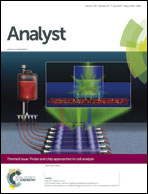Kinetic characterization of the retinoic X receptor binding to specific and unspecific DNA oligoduplexes with a quartz crystal microbalance†
Abstract
Quartz Crystal Microbalance (QCM) biosensor technology was used to study the interaction of the DNA-binding domain (DBD) of the transcription factor RXRα with immobilized specific (DR1) and unspecific (DR1neg) DNA oligoduplexes. We identify the QCM sensor frequency at the susceptance minimum (fBmin) as a better measuring parameter, and we show that fBmin is proportional to the mass adsorbed at the sensor surface and is not influenced by interferences coming from viscoelastic variations of the adsorbed layers or buffers. This parameter was used to study the binding of RXRα to DNA and to calculate the association and dissociation kinetic constants of RXRαDBD–DR1 interaction. We show that RXRαDBD binds to DNA both as a monomer and as a homodimer, and that the mechanism of binding is salt dependent and occurs in two steps. The QCM biosensor data reveal that a high ionic strength buffer prevents the unspecific interactions and at a lower ionic strength the dissociation of RXRαDBD–DR1 occurs in two phases.


 Please wait while we load your content...
Please wait while we load your content...